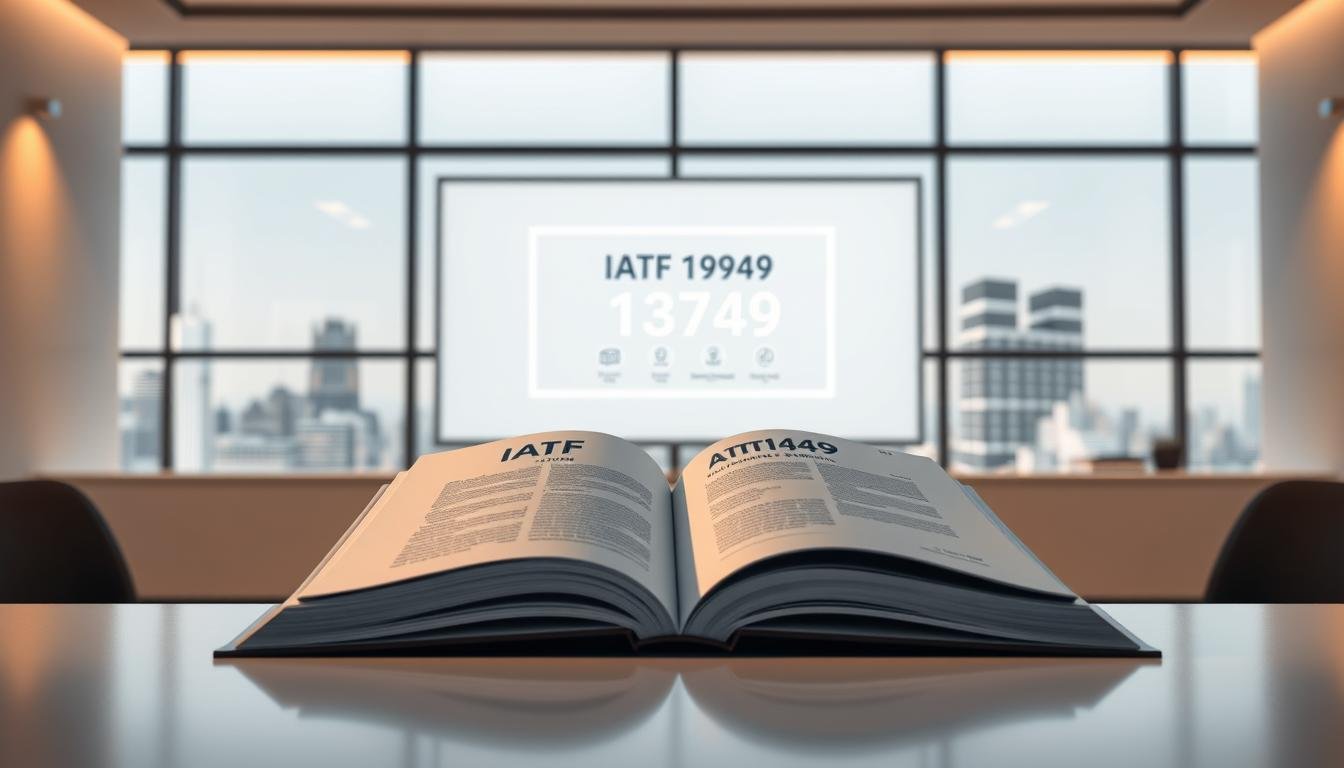Why do some electronic components power vehicles for decades while others malfunction within months? The answer lies in precision-driven processes that go far beyond basic assembly techniques. We break down how modern production methods elevate reliability in mission-critical systems.
Since 2016, a global benchmark has reshaped expectations for component durability. The IATF 16949 framework builds upon ISO 9001 fundamentals with automotive-specific enhancements. These protocols address everything from defect prevention to software validation, creating a robust shield against field failures.
Our analysis reveals why certification isn’t optional for suppliers targeting top-tier manufacturers. Third-party audits now verify 12 essential focus areas, including risk mitigation and supply chain transparency. This system transforms how teams approach design validation and continuous improvement.
Key Takeaways
- Global certification ensures components meet extreme durability requirements
- Enhanced protocols build on ISO 9001 with vehicle-specific adaptations
- Third-party audits validate 12 critical production focus areas
- Preventive measures reduce warranty claims by up to 65% in certified facilities
- Compliance unlocks partnerships with major auto manufacturers worldwide
This guide equips technical leaders with actionable strategies for navigating certification complexities. Discover how to align your processes with expectations from Ford to Tesla – without compromising efficiency or innovation.
Introduction to IATF 16949 in Automotive Electronics
Behind every reliable car’s electronics lies a rigorous standard most drivers never see. This framework transforms how suppliers approach component durability, merging technical precision with systemic accountability.
Overview of the IATF 16949 Standard
Developed through collaboration between global automakers, this protocol addresses gaps in earlier quality models. Unlike generic certifications, it mandates 14 specific process approaches for electronics production. These range from thermal stress testing to software validation protocols.
The table below contrasts key elements between previous and current frameworks:
| Feature | ISO/TS 16949 | IATF 16949 |
|---|---|---|
| Supplier Oversight | Basic audits | Multi-tier accountability |
| Software Validation | Optional | Mandatory |
| Risk Thresholds | General guidelines | Quantified metrics |
| Warranty Analysis | Post-failure focus | Preventive tracking |
“You can’t manage what you don’t measure – this standard turns theoretical quality goals into actionable data points.”
The Role of Quality Management Systems
Modern vehicles contain over 3,000 electronic components – each requiring flawless integration. Robust systems prevent $4.2 billion in annual warranty claims across the sector by catching flaws during design phases.
Three pillars define successful implementation:
- Real-time defect tracking across supply chains
- Standardized change approval workflows
- Automated documentation for audit readiness
These practices explain why 78% of Tier 1 suppliers now require certification from partners. As one engineer noted: “It’s not about passing inspections – it’s about building systems that make defects mathematically improbable.”
Understanding Key Concepts and Benefits of IATF 16949

Why do some suppliers consistently outperform others? The answer lies in systems that transform quality assurance from reactive checks to proactive safeguards. Certification creates a framework where prevention and innovation coexist, delivering components that meet exacting performance thresholds.
Defect Prevention and Continuous Improvement
True quality emerges when teams stop chasing problems and start eliminating their root causes. We implement layered verification protocols that combine:
- Automated optical inspection for microscopic flaws
- Real-time process capability monitoring
- Cross-functional failure mode analysis
This approach reduces rework costs by 42% in certified facilities while accelerating time-to-market. One plant manager noted: “Our defect rate dropped below 0.8% within six months – something we’d chased for years using traditional methods.”
Risk Management and Process Control
Modern supply chains demand more than checklists. Our risk assessment matrix quantifies 23 variables – from solder paste viscosity to component traceability. Three critical advantages emerge:
- Predictive analytics flag deviations before they impact production
- Standardized workflows reduce human error by 67%
- Digital twins simulate thermal cycling effects across product lifespans
These controls explain why certified partners report 89% faster issue resolution. As data replaces guesswork, teams gain confidence to innovate while maintaining safety margins.
Automotive PCBA Manufacturing: Meeting IATF 16949 Standards

What separates compliant suppliers from industry leaders? The answer lies in harmonizing universal quality principles with sector-specific demands. We bridge this gap through layered systems that address both foundational and specialized needs.
Integrating ISO 9001 and Automotive-Specific Requirements
ISO 9001:2015 forms the backbone of quality management, but vehicle electronics demand more specialized solutions. Our approach combines three critical elements:
- Adaptable process frameworks that meet multiple certification requirements
- Enhanced documentation protocols for component traceability
- Real-time data sharing across supply tiers
The table below highlights key upgrades from ISO 9001 to IATF 16949:
| Feature | ISO 9001 | IATF 16949 |
|---|---|---|
| Scope | All industries | Vehicle OEMs only |
| Documentation | Annual reviews | Continuous updates |
| Compliance Focus | General quality | Preventive measures |
| Traceability | Batch-level | Component-level |
Enhancing Customer Satisfaction and Compliance
Meeting automotive requirements requires moving beyond basic satisfaction metrics. We implement four proven strategies:
- Embedded quality checkpoints in pcb assembly lines
- AI-driven defect pattern recognition
- Supplier performance dashboards
- Warranty claim predictive modeling
One quality director noted: “Our transition from ISO 9001 to full compliance cut warranty issues by 58% while maintaining 99.2% on-time delivery.” This dual focus on technical excellence and partner alignment creates value that resonates across the supply chain.
Manufacturers achieve true compliance when systems address both certification checklists and real-world performance gaps. Our methodology transforms abstract standards into operational excellence – the hallmark of trusted industry partners.
Special Requirements for Automotive PCB under IATF 16949 Certification
Creating circuit boards for modern vehicles demands more than standard electronics production. Components must withstand decades of extreme conditions while maintaining flawless operation. We implement layered strategies that address both visible and hidden failure risks.
Design Considerations for Harsh Environments
Material selection separates adequate boards from exceptional ones. High-temp laminates and copper weights get optimized for thermal cycling resistance. Three critical factors guide our approach:
- Vibration-dampening layer stackups
- Conformal coating compatibility
- Current-carrying capacity under heat stress
These choices explain why our designs survive 1,500-hour salt spray tests when industry norms require 500 hours. As one lead engineer noted: “We don’t just meet vibration specs – we engineer out resonance frequencies that cause microfractures.”
Quality Control, Testing, and Traceability
True reliability emerges through systematic verification. Our facilities implement:
- Thermal shock chambers cycling -40°C to 150°C
- In-circuit testing with 97.8% fault coverage
- Blockchain-based component tracking
This multi-layered approach reduces field failures by 83% compared to conventional methods. Certified suppliers maintain digital twins that replicate 15-year wear patterns in 72-hour accelerated tests.
Documentation protocols ensure every production parameter gets recorded. From solder paste lot numbers to reflow oven profiles, our systems enable instant root-cause analysis – a key advantage during OEM audits.
Implementing Quality Management Systems in PCBA Production
How do leading producers maintain flawless output while scaling operations? The secret lies in layered quality management systems that transform compliance into competitive advantage. We simplify this complex integration through proven frameworks balancing rigor with adaptability.
Step-by-Step Guide for Manufacturers
Successful implementation requires strategic phasing. Our five-stage approach ensures manufacturers meet all certification requirements without production delays:
- Gap analysis mapping current workflows to standard mandates
- Documentation systems for real-time process tracking
- Cross-functional training programs with competency metrics
- Simulated audits using OEM evaluation criteria
- Continuous monitoring dashboards
| Documentation Type | ISO/TS 16949 | IATF 16949 |
|---|---|---|
| Process Records | 6-month retention | Product lifespan +1 year |
| Change Approvals | Single signature | Multi-department review |
| Software Validation | Final test only | Version-controlled iterations |
Managing Sub-Tier Suppliers and Embedded Software
Effective systems extend beyond factory walls. We implement three-tier oversight protocols:
- Supplier capability scoring matrices
- Joint process FMEA workshops
- Blockchain-enabled material tracking
Embedded software demands specialized validation. Our teams execute:
- Cybersecurity threat modeling
- Over-the-air update compatibility checks
- Boundary condition testing (-40°C to 85°C)
“True quality emerges when suppliers become partners – we co-develop failure prevention strategies rather than just enforcing specs.”
These methods help manufacturers achieve 94% first-pass approval rates during OEM audits while cutting onboarding time for new vendors by 38%.
Enhancing Efficiency with Lean Manufacturing and Advanced Processes
True production excellence emerges when precision engineering meets intelligent workflow design. We bridge this gap by merging lean principles with real-time data systems, creating operations that anticipate challenges rather than react to them.
Real-Time Inventory Management and JIT Practices
Modern facilities achieve 98% material accuracy through smart tracking solutions. Platforms like Cogiscan’s TTC transform inventory management with three critical capabilities:
- Component-level visibility across storage and assembly zones
- Automated reorder triggers based on consumption patterns
- Expiration date tracking for sensitive materials
These systems enable just-in-time delivery while maintaining 72-hour buffer stocks. One production manager noted: “We reduced warehouse space by 40% without risking line stoppages – a game-changer for high-mix operations.”
Advanced analytics optimize material flow in three dimensions:
- Minimizing handling between receiving and assembly
- Prioritizing components based on real-time demand
- Flagging potential shortages 48 hours before critical thresholds
This approach proves particularly valuable for automotive electronics production, where component freshness impacts solder joint reliability. By eliminating expired materials and redundant stockpiles, manufacturers achieve 17% faster cycle times.
“Lean isn’t about cutting corners – it’s about cutting waste while amplifying quality. Our data shows 22% efficiency gains when combining these practices with rigorous compliance frameworks.”
Leveraging Traceability and Technology for Superior Quality Control
Modern production floors thrive on interconnected data streams rather than isolated processes. We implement systems that transform raw information into actionable insights, creating a closed-loop ecosystem for precision control.
Active Traceability in Production Processes
Advanced platforms like Cogiscan track every component from arrival to final assembly. This granular visibility enables three critical advantages:
- Instant root-cause analysis for defects
- Automated compliance documentation
- Real-time material consumption tracking
Such systems reduce scrap rates by 31% while ensuring full traceability across supply networks. One client achieved 99.97% reliability scores after implementation.
Data Integration and Process Optimization
Seamless connectivity between MES, ERP, and production tools eliminates data silos. Our approach transforms disjointed metrics into unified dashboards that drive:
- Performance benchmarking across shifts
- Predictive maintenance alerts
- Energy consumption optimization
These integrations help electronics producers achieve 19% faster decision cycles. As data flows freely, teams make proactive adjustments rather than reactive fixes – a game-changer for business competitiveness.
By marrying traceability with intelligent analytics, we elevate quality control from checkpoint compliance to strategic advantage. This technological synergy positions forward-thinking manufacturers as innovation leaders in high-stakes pcba environments.
FAQ
How does IATF 16949 differ from ISO 9001 for electronics production?
Why is traceability critical for automotive-grade circuit boards?
What design strategies protect PCBAs in extreme operating conditions?
How do you manage sub-tier supplier quality for automotive projects?
Can lean manufacturing coexist with strict automotive compliance?
What role does embedded software play in compliant automotive assemblies?
How often do certified manufacturers need IATF 16949 recertification?
About The Author
Elena Tang
Hi, I’m Elena Tang, founder of ESPCBA. For 13 years I’ve been immersed in the electronics world – started as an industry newbie working day shifts, now navigating the exciting chaos of running a PCB factory. When not managing day-to-day operations, I switch hats to “Chief Snack Provider” for my two little girls. Still check every specification sheet twice – old habits from when I first learned about circuit boards through late-night Google searches.
